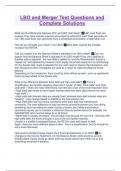Exam (elaborations)
LBO and Merger Test Questions and Complete Solutions
- Course
- Institution
What are the differences between DCF and LBO cash flows? LBO cash flows are levered. They have interest expense accounted for while DCF cash flows generally do not. LBO cash flows also generally have a scheduled amortization of debt taken out. How do you increase your return in an LBO? More debt, ...
[Show more]



